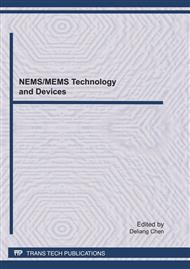p.171
p.175
p.179
p.183
p.187
p.191
p.195
p.199
p.203
Effect of Substrate Temperature on Properties of Silicon Nitride Films Deposited by RF Magnetron Sputtering
Abstract:
In the present work, we report the preparation, characterization and application of silicon nitride thin films deposited by RF magnetron sputtering on oxidized silicon substrates. The properties of the films were investigated with respect to the substrate temperature during film deposition. X-ray energy dispersive spectroscopy confirms the presence of silicon and nitrogen in the films. The X-ray diffraction results indicate that the films were amorphous when deposited without external substrate heating. On the other hand, the deposition on heated substrate (300 °C) results in weakly crystalline structure. Spectral reflectance technique was used for thickness and refractive index measurements. With substrate heating, the refractive index was observed to increase. Atomic force microscope images revealed that the films were smooth and had uniform texture. The etching characteristics of the films in buffered hydrofluoric acid at room temperature and 40 wt % potassium hydroxide at 80 °C were also investigated. Significant reduction in etch rates was observed when the films were deposited on heated substrates. Using the sputter deposited silicon nitride films, microstructures such as cantilevers and diaphragms, which are basic building blocks in micro-electro-mechanical system (MEMS) based sensors, were fabricated using micromachining techniques.
Info:
Periodical:
Pages:
187-190
Citation:
Online since:
May 2011
Authors:
Price:
Сopyright:
© 2011 Trans Tech Publications Ltd. All Rights Reserved
Share:
Citation:


